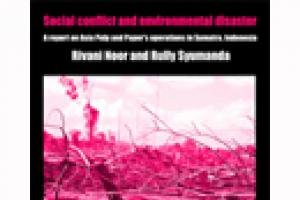Wherever industrial tree plantations are planted in the South, governments provide a range of subsidies to investors. In Indonesia, the government has handed out billions of dollars for plantation development. The plantation and pulp sectors have also received generous aid support. The World Bank and the Asian Development Bank funded studies in the 1980s. A range of export credit agencies helped finance the construction of pulp mills.
Indonesia
Other information
30 September 2006
Publications
22 August 2006
By Rivani Noor and Rully Syumanda
Other information
1 August 2006
Extensive cultivation of oil palm and the resulting oil extraction have always been linked to repression. Plantation cultivation was originally established by colonial regimes. The rapid expansion of plantations in Asia following the Second World War was encouraged in connection with forest clearing and was used as a weapon in combating Malay rebels.
Other information
5 June 2006
On April 12, 2006, the report “The Kalimantan Border Oil Palm Mega-project” was released to show the plans of the Indonesian government to develop up to 3 million hectares of oil palm plantations on the island of Borneo, of which 2 million hectares along the Kalimantan-Malaysia border and 1 million hectares elsewhere --in areas still heavily forested and inhabited by indigenous communities--, to cater for international demand for cheap palm oil to meet the domestic and global demand for bio-fuel.
Other information
6 May 2006
In the last decade, financial institutions and investment banks have handed out more than US$40 billion for new pulp projects in the South. Analysts expect another US$54 billion to be invested in pulp mills in the South by 2015 much of it in Brazil, Uruguay, China, the Mekong Region and the Baltic States.
Bulletin articles
6 May 2006
In 2004, the Minister of Forestry, through Decree No. 101/Menhut-II/2004, issued a policy on accelerating pulpwood development to supply the pulp and paper industry. The policy received broad acceptance in the province of Jambi by PT Wira Karya Sakti (PT WKS), a forestry company subsdiary of the giant Sinar Mas Group (SMG).
Bulletin articles
7 April 2006
Another new FSC certificate of a major logging operation, this time in Indonesia, has got forest watchers scratching their heads.
Bulletin articles
7 March 2006
Earlier this year, a rare thing happened: West Papua hit the headlines. The news was the discovery of a new species of honeyeater bird, a "lost" bird of paradise, a nearly extinct tree kangaroo, 20 new species of frogs, four new butterflies and five new species of palms. The species were found during an expedition to the Foja Mountains organised by Conservation International and the Indonesian Institute of Sciences. "It's as close to the Garden of Eden as you're going to find on Earth," said Bruce Beehler, co-leader of the group.
Bulletin articles
8 February 2006
At the recent "Seafood Summit" conference event in Seattle organized by Seafood Choice Alliance (January 29-30, 2006), the WWF’s “Aquaculture Specialist”, Aaron A. McNevin, PhD, announced that WWF has formed the Sustainable Aquaculture Alliance, which is itself working towards some sort of farmed shrimp certification based upon Best Management Practices.
Bulletin articles
8 January 2006
United Fiber System's plans to build a pulp empire in Kalimantan received a blow in January 2006, when Deutsche Bank confirmed that it has pulled out of its role as financial advisor to UFS. Five months ago, UFS announced that it had appointed Deutsche Bank's Singapore Branch as Financial Advisor on a proposed acquisition of the Kiani Kertas pulp mill in East Kalimantan.
Michael Hoelz, Deutsche Bank's managing director, confirmed in a statement to German NGOs that "Deutsche Bank no longer holds a mandate with UFS".
Other information
16 December 2005
By Haris Retno Susmiyati
Other information
9 December 2005
Asia Pulp and Paper (APP) is one of the world's largest pulp and paper companies. The company is responsible for large-scale deforestation of Indonesia's forests. APP has also generated a number of not-yet-settled conflicts with local communities in Indonesia.
Forthcoming research by Rully Syumanda, Friends of the Earth Indonesia/WALHI's forest campaigner and Rivani Noor of the Community Alliance for Pulp Paper Advocacy (CAPPA) documents the company's grim record in Sumatra.


